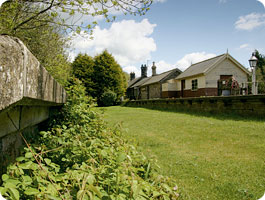The story of Norham Station: Last Man Standing
The story of Norham Station: Last Man Standing
“It was a lovely, happy little station” muses Katherine Short as she guides another visitor around Norham’s railway museum. And she should know having lived there with her husband Peter – the last signalman and station master – for 54 years.

Authorised by the Newcastle & Berwick Railway Act of 1845, the branch from Tweedmouth first appeared on the timetable in July 1849 and, two years later, an end-on junction was made with the St Boswells to Kelso line, creating a 23-mile through route. This unremarkable railway served the border town of Coldstream and a handful of small, rural communities. Its one claim to fame came in 1948 when the East Coast Main Line was flooded and, for three months through the autumn, expresses were diverted along the branch.
Norham was a busy station and home to a trackwalker and six platelayers. Peter Short heard a whisper of an imminent vacancy but, so popular were such outposts, thought that he “hadn’t a cat in hell’s chance of getting it”. A speculative application went in and, against the odds, he got it. The couple spent four years living at nearby Twizel before moving into the station house.



Colour photos: Four by Three
There was plenty to do. Milk churns arrived every morning. Goods came in for local shops and parcels for the villagers. Katherine recalls huge boxes of chickens which sometimes burst open, allowing their contents to flee.
Peter worked the signal box. One night, Mrs S came up with his supper to be confronted by The Flying Scotsman. Inside, the equipment had to be cleaned and polished, and the books kept in order. At precisely half-past-ten every Friday morning, the station master would walk along the platform to inspect the cabin. Peter often read the paper after seeing the 1025 on its way so a mirror was fixed to the wall, carefully aligned to allow his superior’s approach to be monitored without rising from the chair.
When the station master left, the burden of responsibility became heavier. As well as Norham, Peter took charge of the goods service at Twizel and Velvet Hall – the yards on either side. Then the Superintendent dropped a bombshell, announcing that the place would close in a few months and just nine of the line’s employees would be offered new posts. The Super suggested that Peter bought the station and concentrate on the coal business which he’d been running for some time.

Mr Short was the last man standing when he signalled the final freight train out of Norham on 29th March 1965. Eighteen months later, word came through that one of the tracks would be lifted as well as the sidings. The reclamation gang behaved like animals – removing anything steel and smashing the ten-tonne weighbridge. When they returned to complete the job, the signalbox was vandalised and a small fire started. The fireplace was unceremoniously pulled out together with the levers and frame.


Hours of back-breaking labour rescued the cabin from demolition and today, thanks to the installation of salvaged equipment, it looks much as it did forty years ago. Although a manicured lawn grows between the platforms, the booking office and porters’ room survive as home to an overwhelming hoard of railway artefacts. Norham’s rebirth as a museum might, in part, have been an unexpected consequence of its Grade II listing but it now stands as a glorious monument to the country station and its role in local life.
This nostalgic time warp is free to enter on Bank Holiday afternoons and can be found seven miles south-west of Berwick, just off the A698. For weekday tours, call 01289 382217.
More Information
| Daily Mail | Story about the sale of the station |






